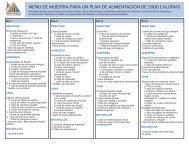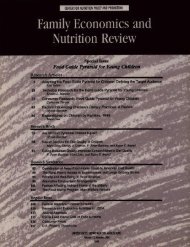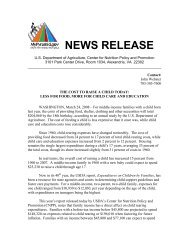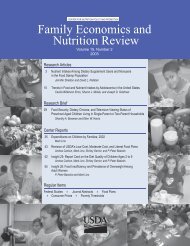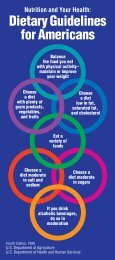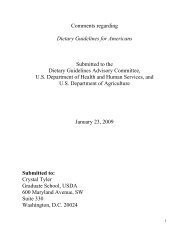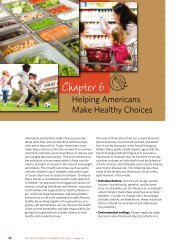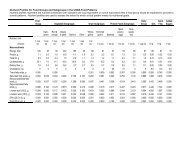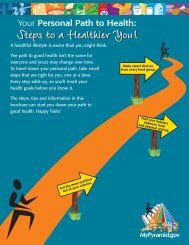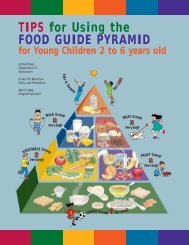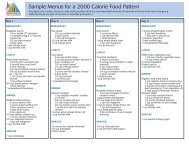Elderly Nutrition - Center for Nutrition Policy and Promotion - US ...
Elderly Nutrition - Center for Nutrition Policy and Promotion - US ...
Elderly Nutrition - Center for Nutrition Policy and Promotion - US ...
Create successful ePaper yourself
Turn your PDF publications into a flip-book with our unique Google optimized e-Paper software.
Many of the participants’ per<strong>for</strong>mance<br />
on the fitness batteries improved<br />
significantly after the intervention.<br />
The mean score of the short-battery<br />
<strong>for</strong>m of the Established Populations<br />
<strong>for</strong> Epidemiologic Studies of the<br />
<strong>Elderly</strong> improved significantly (8.0<br />
to 8.3), with more participants moving<br />
toward the higher end of the functional<br />
spectrum. The percentage of participants<br />
in the low category of the shortbattery<br />
test remained the same at 17<br />
percent (pre- <strong>and</strong> post-test), while the<br />
average category decreased from 51<br />
to 41 percent <strong>and</strong> the high category<br />
increased from 32 to 42 percent. The<br />
per<strong>for</strong>mance on all measures of the<br />
Fullerton Functional Fitness Test<br />
improved significantly.<br />
Discussion<br />
“Take Charge of Your Health <strong>for</strong><br />
Older Adults”—a nutrition <strong>and</strong> health<br />
promotion program <strong>for</strong> older adults in<br />
Georgia—proved to be successful, with<br />
major outcomes that included positive<br />
changes in knowledge related to nutrition<br />
<strong>and</strong> physical activity, improvements<br />
in some health behaviors related<br />
to diet <strong>and</strong> physical activity, <strong>and</strong><br />
decreases in possible barriers to<br />
physical activity.<br />
Each of the three key areas of the<br />
“Take Charge of Your Health <strong>for</strong><br />
Older Adults” campaign message—<br />
Take 5 a Day, Take Down Fat, <strong>and</strong><br />
Take Action—improved significantly,<br />
especially the participants’ knowledge<br />
of health-promoting behaviors. Although<br />
knowledge of appropriate<br />
health behaviors helps improve healthrelated<br />
behavior, skill development<br />
<strong>and</strong> instructional knowledge are almost<br />
always necessary to produce behavior<br />
changes (Krinke, 2001).<br />
While there were gains in knowledge,<br />
not all of these resulted in corresponding<br />
improvements in behavior. For<br />
example, although fruit <strong>and</strong> vegetable<br />
knowledge improved markedly, this<br />
improvement resulted in a significant<br />
increase in self-reported intake of<br />
vegetables (excluding carrots, potatoes,<br />
<strong>and</strong> salad) only—just one of the<br />
questions related to fruit <strong>and</strong> vegetable<br />
intake. Other researchers have reported<br />
similar changes in fruit <strong>and</strong> vegetable<br />
intake following community-based<br />
interventions (Ciliska et al., 2000).<br />
Cohen <strong>and</strong> colleagues (1998) found an<br />
inverse relationship between perceived<br />
barriers to fruit <strong>and</strong> vegetable intake<br />
<strong>and</strong> income <strong>and</strong> education, the result of<br />
which was lower consumption of fruits<br />
<strong>and</strong> vegetables. The results of our<br />
evaluation highlight the need <strong>for</strong><br />
future programs to target <strong>and</strong> address<br />
the perceived barriers to fruit <strong>and</strong><br />
vegetable intake in this population.<br />
Increases in knowledge about the types<br />
of fat <strong>and</strong> the need to decrease dietary<br />
fat intake resulted in improved dietary<br />
behaviors. Our findings are similar to<br />
those reported in other samples. For<br />
example, Goldberg <strong>and</strong> colleagues<br />
(1990) found that many older adults<br />
reported making modifications in their<br />
diet to reduce risk factors associated<br />
with chronic diseases. Others also<br />
reported improved intake in targeted<br />
foods, such as lowfat dairy foods <strong>and</strong><br />
fruits <strong>and</strong> vegetables, after participation<br />
in an educational community<br />
gardening project (Hackman &<br />
Wagner, 1990).<br />
This intervention was successful in<br />
addressing <strong>and</strong> dispelling some of the<br />
myths <strong>and</strong> misconceptions associated<br />
with perceptions of three barriers to<br />
physical activity—time constraints,<br />
not liking to be active, <strong>and</strong> safety<br />
concerns—which led to a significant<br />
increase in the percentage of participants<br />
who reported being active on<br />
most days of the week. King (2001)<br />
suggests that effective interactions<br />
<strong>for</strong> promoting regular physical activity<br />
by older adults are dependent on<br />
Many dimensions of physical<br />
activity among the elderly<br />
participants improved<br />
significantly between the<br />
pre- <strong>and</strong> post-test phases<br />
of the study.<br />
2003 Vol. 15 No. 1 53



